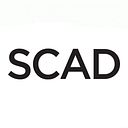Anthony TungNing Huang: dancing in ink
“La Bayadère is one of the greatest ballets in the world,” says Anthony TungNing Huang (M.F.A., illustration, 2021) of the subject of his graduate thesis project, a speculative poster design for The Royal Ballet. “It’s about love, it’s about revenge, it’s about forgiveness, and it’s about closure.”
The creative process that led Huang to his thesis began in Contemporary Art (ARTH 701) class with SCAD art history professor Dr. Rachel Hooper.
“Dr. Hooper introduced examples of artists who had opened up their worlds by using different materials,” remembers Huang. “As an illustrator I thought, how can I use different materials to find myself and grow as an artist? I started off using watercolors, then tried acrylic — both were fun, but not it.”
Then, in the winter of 2020, Huang signed up for Graduate Printmaking Processes (PRMK 602) with professor Curtis Bartone. That experience proved transformative. The first assignment was woodcut relief, and as Huang says, “The moment I touched the gouge, I knew.”
“Printmaking taught me to slow down. I learned how to be more sensitive to values and textures. Becoming a printmaker changed me as an illustrator.”
Huang had the opportunity to work alongside students majoring in a wide range of disciplines, including interior design, painting, and fibers. “It was fascinating to see how everyone’s background manifested in their work, even when we were all working with the same materials.” When winter quarter concluded and the world went into lockdown, Huang began to work on his thesis project largely from his apartment, without full access to studio tools.
“La Bayadère, also known as The Temple Dancer, is adapted from the Indian poetry drama by Kalidasa,” explains the Taiwanese-American Huang. Under the guidance of his thesis chair, professor Arden von Haeger, Huang combined traditional media and new media to create the poster. “I tried to mimic some textures from printmaking. I used monochromatic tones to create a classic feel. I used the form of a ballet dancer to express the grace and sadness of the whole show. I used a sans serif font to echo the logo of the theater itself. And I used environmental elements, symbolic flowers like the lotus.”
Huang’s horizontal design can be cropped to create a billboard, flyers, or other promotional collateral. “I challenged myself by creating a huge image, with more information inside, and a sense of movement by using dancers’ bodies.”
Intriguingly, years before he came to SCAD, Huang was on a path to become a professional ballroom dancer in Shanghai before being waylaid by injury and turning towards visual arts. His sensitivity to movement is apparent in his work. (This physicality is evident in the film on his website that conveys the rhythms of his artistic process and his seriousness of purpose.)
“One reason I chose La Bayadère is because of the history of the story, which goes back to Asia. The more I grow, especially with globalization and the internet, I assume a world citizenship. I want to connect ancient cultures through my work, and make it modern.”
Huang acknowledges another SCAD class, Business and Professional Practices in Illustration (ILLU 774), as influencing his thesis: “As an artist, it’s important to show who you are. But as an illustrator you also need to work with the client. Trying to make your client see what’s interesting about your work and who you are, and how that will make their product more successful, that’s something I learned at SCAD.”
Visit Anthony TungNing Huang.
Written by Peter Relic.
